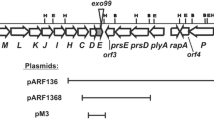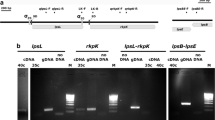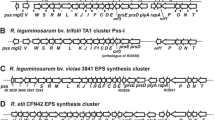Abstract.
Slow-growing cowpea Rhizobium sp. S2, a pigeon pea isolate, showed excessive synthesis of exopolysaccharide (EPS) and nod factor(s) only when grown in the presence of corresponding host root exudate (RE) or naringenin (a flavonoid present in RE of pigeon pea). muc− strain, a plasmid-cured derivative of the parent strain, showed negligible EPS production and failed to synthesize the nod factor(s) under similar growth conditions. The nod factor(s) was extracted and partially purified from the total EPS of the culture supernatant of S2 grown in the presence of either RE or naringenin by the butanol-soluble, ethyl acetate-insoluble method. The parent strain also showed ex-planta nitrogenase activity, whereas in muc− it was not detectable. In contrast to observations of the location of nod, nif- and EPS-synthesizing genes on the chromosome in commonly studied cowpea Rhizobia and Bradyrhizobium sp. colony blot and dot blot hybridization studies revealed the presence of nod (common nod genes), nif (nif KDH); and EPS (pss) determinants to be on the large plasmid in the parent strain and therefore absent in muc−, which is a plasmid-cured derivative.
Similar content being viewed by others
Author information
Authors and Affiliations
Additional information
Received: 10 June 1997 / Accepted: 11 July 1997
Rights and permissions
About this article
Cite this article
Pandya, S., Desai, A. Localization of Nod, Nif, and Acidic Exopolysaccharide Determinants on a Large Plasmid in Slow-Growing Cowpea Rhizobium sp. S2 . Curr Microbiol 36, 36–40 (1998). https://doi.org/10.1007/s002849900276
Issue Date:
DOI: https://doi.org/10.1007/s002849900276




